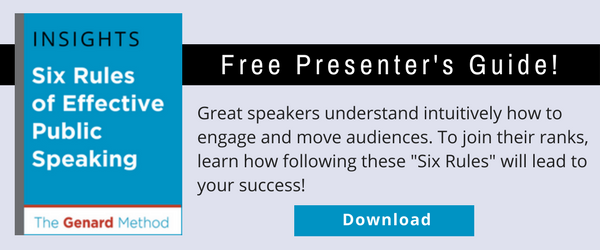
The road to hell is paved with good intentions, and bad public speaking advice. Here are 6 tips guaranteed to send you in the direction you don't want to go.
As a speech coach, I perform my share of triage when it comes to undoing the damage of bad public speaking advice. Although offered with the best of intentions, these nostrums leave speakers headed in the wrong direction. They're usually given by people who aren't speech experts, though some professional trainers are guilty as well.
Often, directives like these come from people who don't have a background in performance. So it's no wonder they leave speakers unprepared to connect with and move audiences. Below are six of these persistent-and-problematic pieces of advice. In each case, I've included tips on what you can do instead to be a confident and aware speaker who knows how to move audiences.
Connecting with listeners includes using the right language. When you have great content and you're ready, why spoil it by saying things that will weaken your influence? Stay in positive territory! Download my free guide, "25 Words or Phrases to Avoid in Speeches and Presentations."

1. Improve Your Public Speaking by Prescription
Every public speaking situation is unique in some way. That is, public speaking is situational. What works at one venue and on one occasion won't necessarily succeed in another. That's because the components are different: the audience, you, recent events—but most of all, what you're trying to accomplish by speaking to this particular group.
Nothing kills spontaneity and the flexibility of being in the moment like Presentation Rules. You've heard them: No more than 7 lines in a PowerPoint slide, with a maximum of eight words per line (or something similar). There's even a "rule" specifying how many slides your talk should contain, the number of minutes it should last, and the minimum point slide of the text.
If you aspire to become one of the replicants (androids) in Blade Runner, by all means follow these directives. Otherwise, think carefully about how to reach your listeners, keep them engaged, foster a discussion, and take them on a journey. You can't do so—even when delivering the same presentation to different audiences—by filling a prescription.

2. Picture Your Audience Naked
Surprised this one is still around? Me too! (Variation: Imagine your audience in their underwear.)
I don't know about you, but the last thing that would keep me focused and mindful is picturing everyone in the room without any clothes on. Yes, it's silly advice. But it hints at something that's truly limiting to effective public speaking.
That's pretending that what's actually happening, isn't. What makes public speaking exciting (like a powerful performance in the theater) is the sense of something transformative taking place here and now. It's live and it's immediate and everyone can feel it. That never happens when you remove reality from the equation. There's no need, in fact, to imagine anything about your audience: they're here, they are paying attention, and are ready and willing to be influenced by you. That's the naked truth!

3. Reveal Your Fear of Public Speaking
We all want to feel that an audience is on our side. So why not help get them there, especially if you have speech anxiety? "I know I'm going to look nervous" (you may think), "so why not just reveal that at the start to gain everyone's sympathy?"
You've experienced speakers taking this approach, haven't you: "Excuse me if I look nervous, public speaking always freaks me out." I once heard a prosecuting attorney make this confession to a jury in her opening statement, adding "I've never done this before"!
If you experience stage fright and someone gives you this advice, remind them that most nervousness isn't visible. You may give an entire presentation feeling nervous throughout, without your audience being any the wiser. Telling listeners that you're a bundle of nerves, however, will have them looking for evidence of it, while half-listening to what you're saying.

4. Knock, Knock . . . Always Start Out with a Joke
A priest, a rabbi, and a rooster walk into a bar. The rooster says to the bartender: "What's the difference between a joke and humor?" The bartender thinks about it a minute. Then he says, "Well, a joke is a zero-sum game, that either succeeds or falls flat, so you and everyone else are embarrassed. Humor is gentler, and much easier to relate to your topic."
That's no joke—and neither is starting out your speech with one. Think of it this way: The joke you're thinking of using wasn't created for your talk. Using it in your speech is grafting it onto your presentation, hoping that this Frankenstein monster will have everyone in stitches. Instead, think about the humorous aspects of your topic and share one or more of them with your audience. That's how you'll get listeners on your side.

5. Avoid Showing Emotion
It's clear that emotions have little place in rational decision-making, isn't it? And that persuading people through speeches and presentations depends entirely upon logic and evidence?
If those sound like leading questions to you, you're right. The idea that you shouldn't show much emotion when you speak is triply bad advice. First, it stunts your ability to achieve empathy with listeners and reveal you have skin in the game. Second, business speakers have a tendency to play it safe in presentations, not wanting to appear vulnerable. The third reason is equally surprising and fascinating. It concerns the fact that emotions are a critically important part of decision-making. In fact, scientists have discovered that people whose limbic system is damaged can't make decisions, even those that seem completely logical:
Effective decision making is not possible without the motivation and meaning provided by emotional input. . . . Feelings provide the basis for human reason—brain-damaged patients left devoid of emotion struggle to make the most elementary decisions. *
Every element of persuasion, buy-in, and inspiration in your talks then, is in part emotionally driven. Connecting with audiences though emotional intelligence, therefore, is part of making your message powerful.

6. Calm Down!
Finally, perhaps the most challenging bit of advice, especially for anyone with speech anxiety: calm down and you'll be fine. Aside from being basically impossible to achieve in the run-up to an important talk, this advice is actually counter-productive to an energized performance.
It's true that I wrote the book Fearless Speaking, and a large part of my practice is helping speakers overcome stage fright. In that work—which includes many varied techniques for calming, centering oneself, and achieving mindfulness as a speaker—I advocate quieting the storm of speaking fear in practice sessions and to help build new habits.
Your speech itself needs the energy-rush and adrenaline of every great performance. In fact, much of the activation you feel physically doesn't differ between exciting (good) situations and fearful (bad) ones. Heart rate, changes in breathing, the release of stress hormones, changes in blood flow to vital organs—in both cases, you're literally getting excited.
Can you process your response differently so you interpret these sensations as the run-up to a thrilling rather than fearful event? You can, and should. It's more productive to prime yourself for exercising power when in fact you need to do that, instead of pointing yourself in the opposite direction.
* Source: https://www.wired.com/2014/03/neuroscience-decision-making-explained-30-seconds/
You should follow me on Twitter here.



